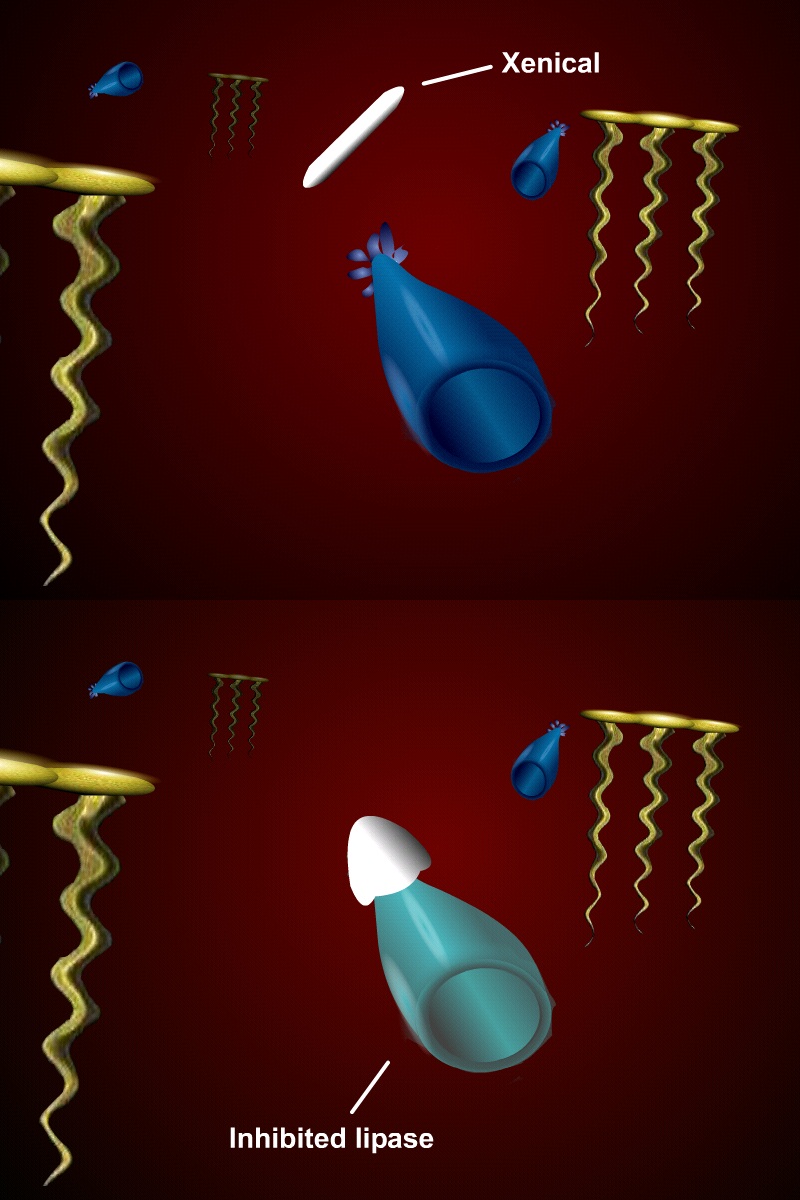
.png)
Figure 1. Lipase inhibitor’s mechanism of action.
To briefly review physiology and gastroenterology we learned in medical school, most of the ingested fat, i.e. triacylglycerol (TG), is degraded by pancreatic lipase into 2-monoacylglycerol and two free fatty acids (FFA). Then, it is combined with bile to form micelles and absorbed by intestinal villi. It is resynthesized into TG to form chylomicrom and moved to the lymphatic system.
In the drug’s most important mechanism of action, the beta-lactone ring of orlistat acts like TG to bind with pancreatic lipase. This results in long-term inhibition of lipase action to prevent degradation of TG. It is assumed that orlistat inhibits about 30% of pancreatic lipase activity. Fat absorption returns to normal soon after discontinuation.
It was found that individuals combining a diet and lipase inhibitor lost on average 2-4 kg more than those who only carried out a diet. The degree and speed of weight loss were similar between individuals on a caloric reduction by 500Kcal and 1,000Kcal. Therefore, we can assume that oral lipase inhibiton therapy combined with about 600Kcal caloric reduction will effectively bring weight loss.

Figure 2. Lipase inhibitor’s mechanism of action.
Formulation and Dosage
In Korea, a single capsule 60mg, 120mg formulations are available. Whereas the 60mg capsule is available over-the-counter in the US, all formulations are prescription drugs in Korea. Three daily administrations of 120mg capsules lead to the largest weight loss and would be an appropriate dosing regimen.
Side Effects of Lipase Inhibitors
As 95-97% of the drug is intestinally excreted and not absorbed, most side effects are limited to the gastrointestinal tract. Mild side effects include increased volume of stool, watery stool, diarrhea, stomachache, sudden bowel movement and abdominal distension. However, side effects such as steatorrhea and flatulence with discharge cause great discomfort. In the early stage, steatorrhea occurs in about 31% and flatulence with discharge in about 18% of patients. But the incidences decrease to 5% and 1%, respectively, in patients on therapy for over a year. Some patients tend to believe that existence of fat in their stool shows that the drug is effective. It is important to explain that the presence of steatorrhea is not related to the efficacy of the drug.
[Advertisement] MAGNUM(Q-switched Nd:YAG Laser) – Manufacturer: (www.i-dana.com)]
The Value of Lipase Inhibitor
Lipase inhibitors are used much less frequently than appetite suppressants due to the belief that the Korean diet is leaner than the Western diet, however, its value is still high. I summarize major findings of various studies on the lipase inhibitors as below.
First, lipase inhibitors are very safe and have been in use around the world for almost two decades without reports of serious side effects.
Second, they are approved for use in pediatric population aged 12 and older.
Third, regardless of the degree of weight loss, lipase inhibitors brought clear improvement of type 2 diabetes, impaired glucose tolerance, hyperlipidemia, and cardiovascular disorders with little interaction with other medications.
Fourth, the degree and speed of weight loss are not too dependent on the amount of caloric reduction.
As mentioned above, the fat content of the Korean diet is continuously increasing and Koreans are more frequently eating Western style meals. Especially the younger generation prefer high-fat, high-calorie foods such as brunches, and desserts. This is why lipase inhibitors need to be considered as an important choice in anti-obesity therapy.
-To be continued




















